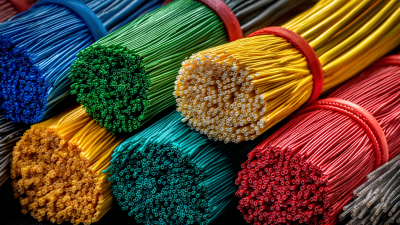
-
Home
-
Products
-
PVC Cable Material
-
Low Smoke Zero Halogen Cable Material
-
Cable material
-
Optical fiber cable
-
-
About Us
-
VR
-
News
-
Blog
-
Contact Us
Leave Your Message

The integration of Fiber Reinforced Polymer (FRP) cables in construction and infrastructure projects has garnered significant attention due to their exceptional durability and performance characteristics. As reported by the American Concrete Institute, FRP materials can reduce the weight of structures by up to 75% compared to traditional materials while providing superior resistance to environmental factors, such as corrosion. To maximize the efficacy of these advanced materials, optimizing the FRP Cable Strengthen Core is essential. Research indicates that an optimized core not only enhances the tensile strength by as much as 30% but also extends the service life of the cables, allowing them to withstand extreme loads and harsh conditions. This article delves into strategies for optimizing the FRP Cable Strengthen Core, ensuring enhanced performance and longevity for diverse applications in today’s demanding engineering landscape.

To enhance the performance and longevity of FRP (Fiber Reinforced Polymer) cables, optimizing the raw material properties for the cable core is crucial. Recent industry reports highlight that the mechanical properties of the fiber used, such as tensile strength and modulus of elasticity, play a significant role in determining the overall performance of FRP cables. For instance, utilizing high-quality carbon fibers can increase tensile strength by up to 200% compared to standard glass fibers, offering improved load-bearing capabilities and better resilience under stress.
Moreover, the matrix material, typically a resin, is equally important in defining the durability of the cable. Studies suggest that incorporating specialized epoxy resins can enhance the thermal and chemical resistance of FRP cables, further contributing to their longevity. According to a report by the American Composites Manufacturers Association, FRP systems utilizing high-performance resins can withstand extreme environmental conditions up to 25 years longer than conventional materials. Optimizing the combination of these raw materials not only accelerates production but ultimately results in FRP cables that maintain their integrity and performance over extended periods, making them a reliable choice for various industrial applications.

Analyzing stress distribution in Fiber Reinforced Polymer (FRP) cables is critical for enhancing their durability and overall performance. Recent industry studies indicate that optimal stress distribution can significantly alleviate localized stress concentrations that often lead to premature failure. For instance, a report by the American Society for Testing and Materials (ASTM) found that correctly designed and implemented stress distribution mechanisms can improve the overall lifespan of FRP cables by up to 30%. This insight emphasizes the need for engineers to meticulously analyze and model stress responses under various loading conditions.
Furthermore, utilizing advanced computational methods such as Finite Element Analysis (FEA) can provide profound insights into the performance of FRP cables under varying environmental conditions. According to data from the Composites Industry Association, FRP materials exhibit exceptional resistance to corrosion and fatigue, yet maintaining an even stress distribution is paramount. The incorporation of strategic core strengthening techniques can effectively enhance the mechanical properties of FRP cables, which not only extends their service life but also boosts structural integrity in demanding applications. Thus, understanding and optimizing stress distribution remain essential for achieving the highest levels of performance in FRP cable applications.
In recent years, the advancement of composite materials has revolutionized the manufacturing of Fiber Reinforced Polymer (FRP) cables. By incorporating advanced composites such as carbon fiber and aramid, engineers can significantly enhance the tensile strength and durability of FRP cables. For instance, data from the Composites World 2023 report indicates that the use of carbon fiber-reinforced composites increases the tensile strength by approximately 30% compared to traditional materials. This improvement not only contributes to improved load-bearing capabilities but also plays a crucial role in reducing material fatigue over time.
Moreover, incorporating hybrid composite systems can further optimize the performance metrics of FRP cables. According to the Journal of Materials Science and Engineering, hybridization with materials like glass fiber can lead to an upsurge in impact resistance by as much as 25%. This enhanced performance in challenging environments makes the FRP cables more reliable, thus extending their operational lifespan. By leveraging these advanced composite materials, industries can ensure that FRP cables meet the increasing demands for longevity and resilience in various applications, ranging from construction to marine environments.
| Material Type | Tensile Strength (MPa) | Weight (g/m) | Flexural Modulus (GPa) | Durability Rating | Cost ($/kg) |
|---|---|---|---|---|---|
| Carbon Fiber | 600 | 120 | 80 | Excellent | 15 |
| Glass Fiber | 350 | 150 | 20 | Good | 5 |
| Aramid Fiber | 500 | 200 | 70 | Very Good | 10 |
The production of Fiber Reinforced Polymer (FRP) cables has entered a new era with the advent of cutting-edge manufacturing techniques. These advanced processes not only streamline production but significantly enhance the mechanical properties of the cables. Techniques such as automated fiber placement and precision resin infusion technology ensure that the composite materials are optimally aligned and uniformly saturated, leading to increased tensile strength and durability. This meticulous approach minimizes defects, allowing for the creation of high-quality cables capable of withstanding extreme environmental conditions.
Moreover, the integration of smart manufacturing technologies, including real-time monitoring and data analytics, plays a pivotal role in improving FRP cable production. These innovations provide manufacturers with insights into the production process, enabling immediate adjustments to maintain quality standards. The implementation of such technologies fosters a responsive manufacturing environment where performance metrics can be continuously evaluated and optimized, driving both the efficiency and longevity of FRP cables. As the industry embraces these advanced methodologies, the potential for enhanced performance and longevity in FRP cables becomes increasingly achievable.
The performance and lifespan of FRP (Fiber Reinforced Polymer) cables are significantly influenced by environmental factors. Parameters such as temperature fluctuations, humidity levels, and exposure to UV radiation can lead to deterioration, impacting both the strength and longevity of the cable. It is important to assess these environmental conditions regularly to ensure that FRP cables maintain their optimal performance.
**Tips:** To enhance the lifespan of FRP cables, consider using UV-resistant coatings and protective sheathing to shield against harsh sunlight. Implementing regular inspections can help identify any signs of wear or damage due to environmental exposure, allowing for timely maintenance.
Additionally, understanding the specific environmental conditions where FRP cables will be installed is crucial. For instance, areas with high humidity may require special formulations of FRP that resist moisture penetration. Optimizing the installation methods to include strategic placement away from extreme weather patterns can further ensure the durability and effectiveness of these cables in the long run.
**Tips:** When installing FRP cables in challenging environments, utilize corrosion-resistant materials and consider the installation angle to avoid water accumulation. Proper planning can mitigate risks and enhance the overall performance of the cable system.






